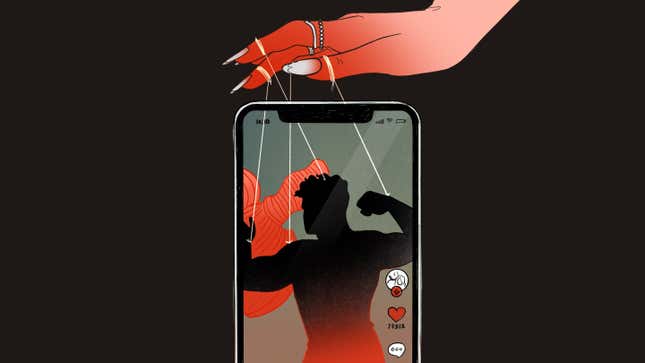TikTok #CouplePranks and the Disappointments of Heterosexuality
Women are inciting straight men toward displays of jealousy, aggression, and the "tragedy of heterosexuality," for lols.
In Depth

The TikTok starts with a view out of a bedroom window onto the street, where a woman’s boyfriend is getting into his car. The boyfriend starts to drive away and then suddenly stops in the middle of the street. He speedily reverses, leaves the car in the middle of the street, and then runs toward the house, not even bothering to close the car door. Onscreen, the text reads: “Texting my boyfriend ‘he’s leaving come over now.’”
The whole thing is a prank—it looks like the woman behind the camera is accidentally sending a text to her boyfriend that is intended for another man. “He’s gonna come in hella mad,” says the woman as she turns the camera to focus on the closed bedroom door. Then she shouts, because her boyfriend has apparently scaled the house onto the second-story roof and is looking in through the bedroom window behind her.
“What the fuck are you texting me,” he says, climbing through the window. The woman behind the camera cracks up. “How did you get in there? I live in a two-story house!” He’s seemingly incredulous at seeing her alone: “I was trying to see who you were with.”
The video has over 2,000 comments, including one reading, “aww he loves her.” It’s part of the viral “he’s leaving” trend, which shows the jealous reactions of boyfriends and husbands to a woman’s fake-out cheating text—all for LOLs. It’s part of the booming genre of #couplepranks on TikTok, which seemed at the start of lockdown like a sensible, cathartic response to stir-crazy cohabitation. (Yes, why not climb into the shower with your unsuspecting husband while wearing a black hooded cape and ghoulish mask?) Lately, though, my FYP has filled up with heterosexual couples doing pranks that are stereotypically gendered: It’s the shenanigans of Punk’d meets the essentialist pronouncements of a blockbuster ’90s relationship advice book.
Typically, the joke is: This Is How Straight Men Are. These pranks often bait guys into expressions of chivalry, jealousy, one-track-minded horniness, or commitment-phobic Peter Pan-dom. They are meant to be funny specifically because they affirm stereotypes about straight men, as well as heterosexual monogamy and domesticity.
Jealousy is the prevailing theme of hetero couple pranks, as in the “he’s leaving, come over now” videos. Another recent trend sees a woman hand her phone to her boyfriend, asking him to try a new Snapchat filter. While he’s looking at the screen, a fake text from a flirtatious “Brad” pops up. The boyfriend might yell something along the lines of, “WHO’S BRAD?” Meanwhile, the girlfriend descends into a fit of laughter. Some TikTokers take it further, as with a woman who pretended to have sex with a dummy, just to capture her boyfriend’s reaction to the prank, which, in the words of her caption, “almost ended in my death lol.” In a similar yet more disturbing video, a man throws his girlfriend off the dummy and onto the floor.
-

-

-

-

-

-

-

-

-

-

-

-

-

-

-

-

-

-

-

-

-

-

-

-

-

-

-

-

-

-

-

-

-

-

-

-

-

-

-

-








































